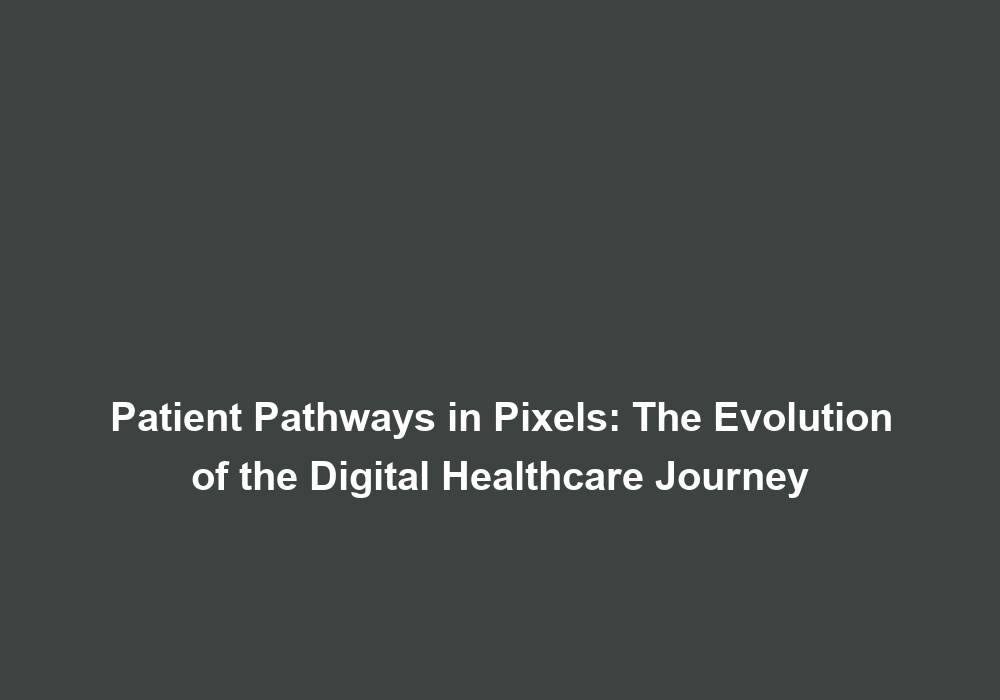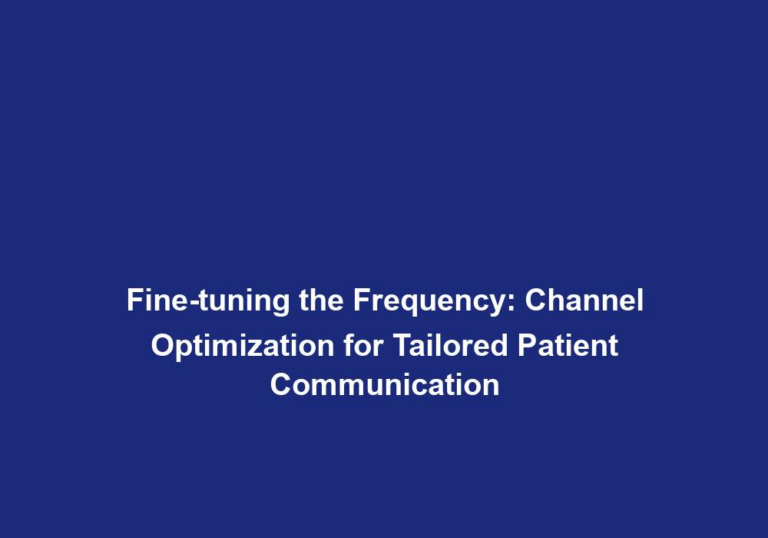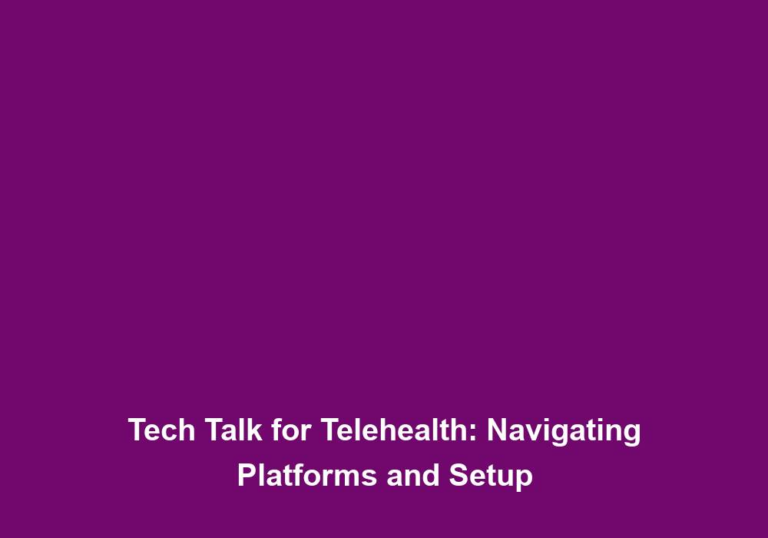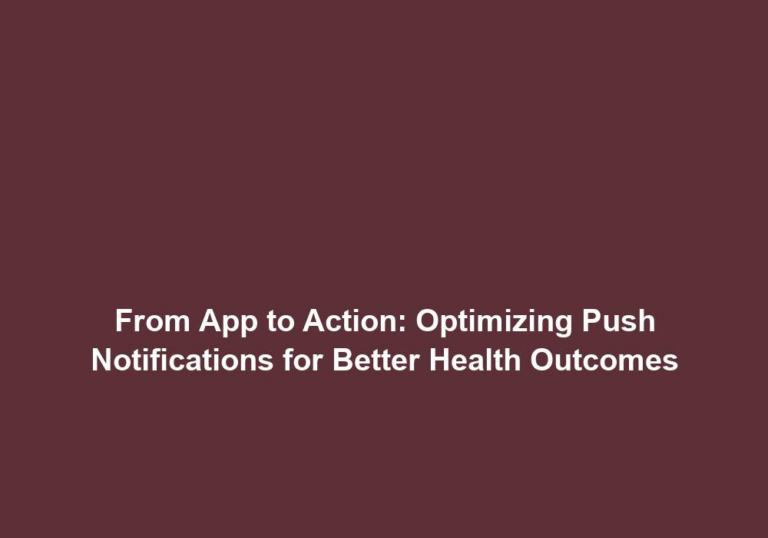Patient Pathways in Pixels: The Evolution of the Digital Healthcare Journey
In today’s digital age, the healthcare industry is undergoing a significant transformation. With advancements in technology and the increasing use of digital platforms, patient pathways have evolved from traditional, paper-based processes to digital ones. This shift has revolutionized the way healthcare is accessed, delivered, and managed. In this article, we will explore the various aspects of this digital healthcare journey and its impact on patient care.
The Role of Digital Technology in Healthcare
Digital technology has become an integral part of healthcare systems, enhancing patient experiences, improving access to care, and streamlining processes. The following are key areas where digital technology has made a significant impact:
1. Electronic Health Records (EHRs)
Electronic Health Records (EHRs) have replaced the traditional paper-based medical records, enabling healthcare providers to access and share patient information securely and efficiently. EHRs eliminate the need for physical storage space, reduce errors in record-keeping, and facilitate better coordination among healthcare professionals involved in a patient’s care.
- EHRs have revolutionized the way patient information is stored and accessed, ensuring that healthcare providers have immediate access to accurate and up-to-date medical records.
- By digitizing medical records, EHRs have eliminated the need for physical storage space, reducing costs and improving efficiency.
- EHRs also enable healthcare professionals to easily share patient information with other providers, resulting in better care coordination and improved patient outcomes.
2. Telehealth and Telemedicine
Telehealth and telemedicine have emerged as essential tools in the digital healthcare journey, especially in remote or underserved areas. These technologies enable patients to access healthcare services remotely through video consultations, virtual visits, and remote monitoring. Telehealth has also proven to be effective in managing chronic conditions and improving patient engagement.
- Telehealth and telemedicine have significantly improved access to healthcare, particularly for individuals residing in remote or underserved areas.
- Through video consultations and virtual visits, patients can receive timely medical advice and treatment without the need for physical visits, reducing travel time and costs.
- Remote monitoring allows healthcare providers to track patients’ health parameters in real-time, enabling early detection of issues and timely interventions.
3. Mobile Applications
The proliferation of smartphones has led to the development of countless healthcare mobile applications. These apps empower patients to monitor their health, access medical information, schedule appointments, and receive personalized notifications. Mobile applications also enable healthcare providers to offer remote support, deliver health education, and track patient progress effectively.
- Healthcare mobile applications have revolutionized patient self-care by providing convenient access to medical information, monitoring tools, and personalized resources.
- Patients can use these apps to track their vital signs, medication adherence, and physical activity, promoting proactive management of their health.
- Healthcare providers can leverage mobile applications to deliver personalized support, educational materials, and reminders, enhancing patient engagement and adherence to treatment plans.
4. Wearable Devices
Wearable devices, such as fitness trackers and smartwatches, have become increasingly popular among individuals interested in monitoring their health and well-being. These devices collect real-time data on various health parameters, including heart rate, sleep patterns, and physical activity. Healthcare providers can leverage this data for preventive care, early detection of abnormalities, and personalized treatment plans.
- Wearable devices have empowered individuals to actively monitor their health on a daily basis, encouraging a proactive approach to well-being.
- By continuously collecting data on vital signs and physical activity, wearable devices provide valuable insights that can help individuals and healthcare providers identify patterns and make informed decisions.
- Healthcare providers can use the data from wearable devices to develop personalized treatment plans, provide targeted interventions, and track patient progress remotely.
The Digital Healthcare Journey
The digital healthcare journey encompasses the entire patient pathway, from seeking healthcare information to post-treatment care. Let’s explore the key stages of this journey:
1. Information and Research
Patients often turn to digital platforms to search for healthcare information, symptoms, and potential treatment options. Search engines, online health portals, and social media platforms play a vital role in providing patients with relevant and reliable information. Healthcare professionals must ensure that accurate and up-to-date content is available to patients during this stage to facilitate informed decision-making.
- Digital platforms provide patients with a wealth of healthcare information, allowing them to research their symptoms, conditions, and treatment options.
- Search engines and online health portals curate reliable and evidence-based information, helping patients make informed decisions about their healthcare.
- Healthcare professionals should actively participate in creating and sharing accurate content to ensure that patients have access to trustworthy information for their research.
2. Appointment Booking and Check-in
Digital platforms have simplified the appointment booking process, eliminating the need for lengthy phone calls or in-person visits. Patients can conveniently schedule appointments through online portals, mobile apps, or even chatbots. Digital check-in systems further streamline the patient experience, reducing waiting times and paperwork.
- Online appointment booking systems provide patients with the flexibility to schedule appointments at their convenience, reducing wait times and improving access to care.
- Mobile apps and chatbots enable patients to book appointments and receive appointment reminders, enhancing patient engagement and reducing no-show rates.
- Digital check-in systems allow patients to complete necessary forms and provide updated information before their visit, minimizing paperwork and improving the efficiency of the check-in process.
3. Virtual Consultations
Telemedicine has gained significant traction, particularly in the wake of the COVID-19 pandemic. Virtual consultations allow patients to connect with healthcare providers remotely, reducing the need for physical visits. Video conferencing, secure messaging, and image sharing enable healthcare professionals to diagnose, treat, and monitor patients effectively.
- Virtual consultations provide patients with the convenience of accessing healthcare services from their homes, eliminating the need for travel and reducing exposure to contagious diseases.
- Video conferencing and secure messaging platforms enable effective communication between patients and healthcare providers, ensuring that patients receive timely and appropriate care.
- Image sharing capabilities allow healthcare professionals to visually assess patients’ conditions, aiding in diagnosis and treatment decision-making.
4. Personal Health Monitoring
The advent of wearable devices and mobile applications has empowered patients to actively monitor their health. Patients can track their vital signs, medication adherence, physical activity, and even mental well-being using these technologies. Real-time data can be shared with healthcare providers, enabling them to provide personalized recommendations and interventions.
- Personal health monitoring tools, such as wearable devices and mobile applications, enable patients to track their health parameters and gain insights into their well-being.
- By monitoring vital signs, physical activity, and medication adherence, patients can actively manage their health and make necessary adjustments to their lifestyle and treatment plans.
- Healthcare providers can review the data shared by patients and provide personalized recommendations, interventions, and support based on the individual’s health status and goals.
5. Remote Monitoring and Care
For patients with chronic conditions or those recovering from surgeries, remote monitoring has proven to be highly effective. Connected devices, such as glucose meters, blood pressure monitors, and continuous monitoring systems, enable healthcare providers to remotely track patient progress, identify potential issues, and intervene when necessary. This approach reduces the need for frequent hospital visits and improves patient convenience.
- Remote monitoring allows healthcare providers to keep track of patients’ health parameters without the need for in-person visits, ensuring timely intervention and proactive management of conditions.
- Connected devices provide patients with the convenience of monitoring their health from home, reducing the burden of frequent hospital visits and improving their quality of life.
- Healthcare providers can analyze the data collected through remote monitoring and make data-driven decisions to optimize treatment plans and improve patient outcomes.
6. Patient Engagement and Education
Digital platforms offer opportunities for healthcare providers to engage and educate patients effectively. Online support groups, educational videos, and interactive tools empower patients to take an active role in their healthcare journey. Engaged patients are more likely to adhere to treatment plans, make lifestyle changes, and achieve better health outcomes.
- Online support groups provide patients with a sense of community, allowing them to connect with others facing similar health challenges and share experiences and knowledge.
- Educational videos and interactive tools enable patients to access reliable health information, learn about their conditions, and acquire self-management skills.
- Engaged patients who actively participate in their healthcare journey are more likely to adhere to treatment plans, make necessary lifestyle changes, and achieve better health outcomes.
The Benefits and Challenges of Digital Healthcare
While the digital healthcare journey offers numerous benefits, it also comes with its own set of challenges. Let’s explore both sides:
Benefits:
-
Improved Access: Digital healthcare eliminates geographic barriers and enables patients to access care from anywhere, particularly in underserved areas.
- Patients in remote or rural areas can benefit from digital healthcare by accessing medical services without the need to travel long distances.
- Digital platforms also enhance access to specialized care, allowing patients to connect with healthcare providers who may be located in a different region or country.
- In underserved areas, digital healthcare can bridge the gap in healthcare availability, ensuring that individuals receive timely and appropriate care.
-
Enhanced Communication: Digital platforms facilitate seamless communication between patients and healthcare providers, leading to better care coordination and reduced misunderstandings.
- Secure messaging platforms enable patients to communicate with healthcare providers, ask questions, and seek clarifications, improving patient-provider communication.
- Digital platforms also allow healthcare providers to share test results, treatment plans, and educational materials with patients, promoting clear and effective communication.
- Improved communication enhances care coordination among different healthcare professionals involved in a patient’s treatment, reducing the risk of errors and improving patient safety.
-
Patient Empowerment: Patients have more control over their health information, can actively participate in decision-making, and access resources for self-management.
- Digital healthcare empowers patients by providing them access to their medical records, test results, and treatment plans, allowing them to actively participate in their care.
- Patients can use digital platforms to research their conditions, access reliable health information, and make informed decisions about their treatment options.
- Online self-management resources, such as educational materials, tracking tools, and support groups, enable patients to take charge of their health and well-being.
-
Efficiency and Cost Savings: Digital technologies streamline processes, reduce paperwork, and enable healthcare providers to deliver care more efficiently, resulting in cost savings.
- Electronic Health Records (EHRs) eliminate the need for physical storage space and manual record-keeping, reducing administrative costs and improving efficiency.
- Digital appointment booking systems and check-in processes minimize paperwork and administrative tasks, allowing healthcare providers to focus more on patient care.
- Telehealth and remote monitoring technologies reduce the need for physical visits, saving patients time and travel expenses while optimizing healthcare resources.
Challenges:
-
Privacy and Security: The use of digital platforms raises concerns about the privacy and security of patient data, requiring robust security measures and adherence to regulatory guidelines.
- Healthcare providers must implement strict security measures, such as encryption and access controls, to protect patient data from unauthorized access or breaches.
- Compliance with privacy regulations, such as HIPAA, is crucial to ensure that patient information is handled securely and confidentially.
- Transparent communication about data security practices and obtaining patient consent for data sharing are essential to maintain patient trust in digital healthcare.
-
Technological Barriers: Not all patients have access to digital devices or reliable internet connectivity, creating a digital divide that may hinder access to care for certain populations.
- Healthcare providers must be mindful of the technological barriers faced by some patients and find alternative ways to ensure equitable access to care.
- Efforts should be made to provide digital literacy training and support to individuals who may be unfamiliar with using digital platforms for healthcare purposes.
- Collaboration with community organizations and government initiatives can help bridge the digital divide and ensure that all patients can benefit from digital healthcare.
-
Information Overload: The abundance of healthcare information available online can be overwhelming for patients, making it crucial for healthcare providers to curate accurate and trustworthy content.
- Healthcare providers should guide patients to reliable sources of information, such as reputable websites and trusted healthcare organizations, to avoid misinformation and confusion.
- Clear and concise communication of medical information is essential to ensure that patients can understand and make informed decisions about their healthcare.
- Healthcare providers can play a role in educating patients about evaluating the credibility of online sources and avoiding information overload.
-
Integration and Interoperability: Seamless integration of various digital systems and interoperability among different healthcare providers’ systems remain significant challenges.
- Healthcare providers need interoperable systems that can seamlessly share patient information to ensure continuity of care and avoid duplication of tests or treatments.
- Collaboration among healthcare organizations and technology vendors is essential to develop standardized protocols and interfaces that enable interoperability.
- Efforts should be made to improve the compatibility of different digital systems, allowing healthcare providers to access and share patient information efficiently.
In conclusion, the digital healthcare journey has transformed patient pathways, making care more accessible, efficient, and patient-centered. From electronic health records to telehealth and mobile applications, digital technology has revolutionized the way healthcare is accessed and delivered. However,







